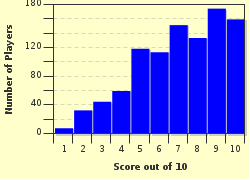Quiz Answer Key and Fun Facts
1. Which quirky and eccentric scientist won the Nobel Prize for Physics in 1921 for his work on the laws of the photoelectric effect?
2. The German physicist, Max Planck, is thought of as a revolutionary in physical science. As one of the founders of quantum theory, his name was given to the constant, 'h'. The Planck constant is [6.63 x (10^-34)Js] where 'J' stands for energy in Joules and 's' stands for the time in seconds. The Planck constant is used in the calculation of the energy of which of these particles by use of the equation E = hf?
3. Using Einstein's theories (no calculations necessary), what can be said about the characteristics of a photon as it travels at the speed of light in a vacuum?
4. By combining Einstein's equation E = mc^2 and another equation for energy, E = hf, it is possible to derive yet another formula which really does simplify the entire concept of wave-particle duality. The equation eventually simplifies to p = h / (lambda) where 'p' represents momentum, 'h' represents the Planck constant and 'lambda' represents wavelength. After which of the following scientists was this equation named?
5. Unstable nuclei form the basis of radioactivity and nuclear decay. Despite not being able to predict when an individual nucleus will decay it is possible to represent, via an exponential decay graph, what time related concept?
6. In the early 20th century, Ernest Rutherford and his team of physicists revolutionised how scientists view the nature of the atom. This was done by firing a beam of alpha particles (helium nuclei) at a leaf of gold and detecting the scattering of the particles thereafter. Which atomic model proposed by JJ Thomson did this experiment end up rejecting?
7. Physics isn't complete unless there are units involved and every student and fan of the science grow to cherish them. So, I think I will share my fondness with you! Experiments carried out have suggested that the diameter of an atomic nucleus is in the region of x10^-15m which is incomprehensibly small. What is the unit given to distances of around 10^-15m?
8. Nuclear fission and nuclear fusion; two similar names but two very different phenomena. One of these processes involves (very) light nuclei joining together thus creating one larger nucleus, but which of the two processes is it? *See hint*
9. The atom derives its name from the Greek word atomos which means uncuttable or indivisible. This is somewhat a misnomer as the atom can be divided into smaller subatomic particles. CERN, a particle and nuclear physics research body, conducts many experiments related to the elusive Higgs boson which include the use of which of the following?
10. Marie Curie, one of the greatest physicists and chemists of all time, was ultimately killed by her work and discoveries which ironically saves so many lives in the modern age. As a result of Curie laying the foundations of radioactive study the humble smoke detector could evolve. Which form of radiation does the smoke detector use?
Source: Author
jonnowales
This quiz was reviewed by FunTrivia editor
crisw before going online.
Any errors found in FunTrivia content are routinely corrected through our feedback system.

